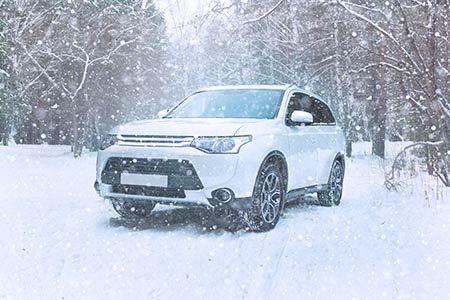Winter's cold temperatures and wet, soggy weather can cause problems for any vehicle that isn't prepared properly. However, if you are well acquainted with the winter tips for cars, you need not worry much about it.

Know how to prepare your car for winter and enjoy a drive in the snow without compromising the vehicle's or your own safety.
Make your own winter car kit
Preparing your car for winter is easier if you have a checklist to begin with. And the first thing in this list is a winter car kit. It's extremely helpful to keep a box of winter supplies in your car trunk while you are driving on the snowy roads. This will keep you prepared for any kind of emergency in case the vehicle breaks down or you are stranded in the cold.
A winter car kit meant for emergencies must include the following supplies:
- Blankets
- Warm clothes
- Radio
- Cellular phone to make emergency calls
- Flashlight
- First aid kit
- Energy-boosting snacks
- Ice scraper
- Road flares
Monitor the tires
The next thing in the checklist is to monitor the car tires. Among all the parts of your car that are vital to its safety during winter, tires are perhaps the most important. When the roads get slippery and covered in snow, slush, and ice, tires are the last line of defense between the vehicle and the road.
Driving with tires without enough air or traction can be a recipe for disaster on icy or snowy roads. That's why a thorough inspection of the tires is one of the most important winter tips for cars to ensure a smooth winter drive.
Check the treads
- Simply take a penny and place it into the tread of your tires with Lincoln's head facing down. If any part of his head is covered by the tread, that means you have at least 2/32" of tread left on your tires.
- On the other side of the coin, if any part of the Lincoln Memorial is covered, that means you have at least 6/32" of tread left.
- To use a quarter, place it in the tread with Washington's head facing down. If any part of his head is covered, that means you have at least 4/32" of tread left.
Legally, your tires are not considered to be bald until the tread is below 2/32". However, for winter driving, you want to maintain the tread between 4/32" and 6/32" for optimal handling on the roads. Your tires will lose traction much more easily in the cold weather and on cold and slippery roadways.
Check the air pressure
During the winter months, the air in tires tends to contract, meaning lower air pressure as compared to other months. You may have to fill up your tires more frequently than you normally would during other parts of the year.
Invest in snow tires
If you really want to prepare your car for winter, you might want to think about investing in a set of snow or winter tires that will really help you get a grip on those slippery, icy winter roads. Winter tires are typically made from a special rubber compound that prevents the tire from getting brittle and worn-out in the low temperatures. They are also specially designed for extra traction.
Check the coolant system
The rough winter weather can put a lot of wear and tear on your coolant system and it will only get worse as the season wears on.
Therefore, getting your car winter ready requires you to keep a check on the coolant system. Here are some useful tips that you can follow:
- Getting the coolant system checked by a mechanic can save a lot of time and effort. Many shops can test out the most important parts of the coolant system, like the radiator, without having to take them apart. It's important that you have the radiator's pressure checked and have all hoses examined for any cracks or tears.
- If there are any parts that seem to be damaged or have gone over the manufacturer's recommended mileage, then it's a good idea to consider getting them replaced with new ones so you're ready for the winter weather and can avoid any mishaps.
- Make sure to replace the coolant in your engine before the winter season. It's cheap and easy, and it helps you avoid engine problems when the weather gets cold. Instead of putting only antifreeze, go for a 50/50 antifreeze/water combination, which will protect your engine against freezing temperatures and oxidation.
Give your car a routine check-up
A routine check-up is extremely crucial in getting your car winter ready. Stay up-to-date with your vehicle's tune-ups. Make sure to regularly change your oil at the manufacturer's recommended intervals, and always keep sufficient gas in your tank. Check all fluids, including transmission fluid, brake fluid, and power-steering fluid to make sure they are all at the necessary levels.
With the roads treacherous and slippery during snow and rainstorms, it's important to have your brakes and rotors checked to make sure they are in good condition. Having fully functional brakes on your car during the winter can prevent an accident when you hit a patch of black ice or go sliding around a snowy turn.
The above-mentioned tips will give you enough knowledge on how to prepare your car for winter and ensure a safe drive. With proper preventive measures, a thorough examination of the vehicle, and emergency winter car kit by your side, you can keep yourself winter ready.